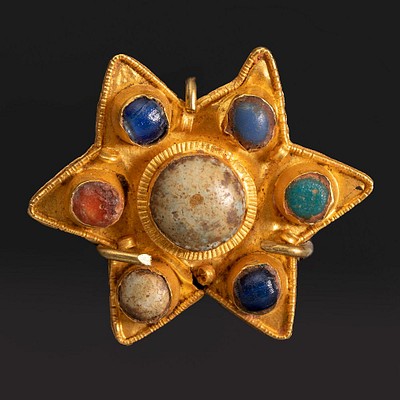ANTONIO DEL CASTILLO Y SAAVEDRA (Cordoba, 1616 - 1668) "Christ tied to the column". Oil on canvas. Relined.
Lot 74
About Seller
Setdart Auction House
Carrer Aragó 346
Barcelona
Spain
Setdart Subastas was born in 2004 and is currently the first online art auction in Spain with solidity, prestige and reliability guaranteed by our more than 60,000 users. Setdart has a young, dynamic and enterprising team ready to successfully manage the purchase and sale of art works through custom...Read more
Estimate:
EUR€10,000 - EUR€12,000
$10,752.69 - $12,903.23
Absentee vs Live bid
Two ways to bid:
- Leave a max absentee bid and the platform will bid on your behalf up to your maximum bid during the live auction.
- Bid live during the auction and your bids will be submitted real-time to the auctioneer.
Bid Increments
| Price | Bid Increment |
|---|---|
| EUR€0 | EUR€10 |
| EUR€200 | EUR€25 |
| EUR€500 | EUR€50 |
| EUR€1,000 | EUR€100 |
| EUR€3,000 | EUR€200 |
| EUR€5,000 | EUR€500 |
| EUR€10,000 | EUR€1,000 |
| EUR€20,000 | EUR€2,000 |
| EUR€50,000 | EUR€5,000 |
About Auction
By Setdart Auction House
Dec 21, 2021
Set Reminder
2021-12-21 07:30:00
2021-12-21 07:30:00
America/New_York
Bidsquare
Bidsquare : Córdoba: 2,000 Years of Art
https://www.bidsquare.com/auctions/setdart-auction-house/c-rdoba-2-000-years-of-art-8049
Setdart Auction House sofia@setdart.com
Setdart Auction House sofia@setdart.com
- Lot Description
ANTONIO DEL CASTILLO Y SAAVEDRA (Cordoba, 1616 - 1668) "Christ tied to the column". Oil on canvas. Relined. Presents faults and repainting. It conserves frame of epoch with faults in the gilding. Measurements: 64.5 x 46 cm; 118 x 71 cm (frame). The author of this work uses a very dynamic and unusual composition, which generates a representation of theatrical character. To this way of conceiving the disposition of the characters, the treatment of the figures is joined, which has its maximum exponent in the figure of Christ, with its flattered anatomical canon and its serpentine posture. Christ on the column or Christ tied to the column is an evangelical scene and a very frequent iconographic theme in Christian art, within the cycle of the Passion. The scene takes place in the Praetorium of Jerusalem, the center of Roman power, directed by Pontius Pilate, where Jesus Christ arrived for the second and last time, after passing through different instances (Annas, Caiaphas and Herod). In this biblical episode Christ is exhibited before the one who preferred to free Barabbas rather than him. He is stripped of his clothes and tied to a column, where he is subjected to mockery and torture, among them, the scourging and the crowning with thorns, iconographic denominations that sometimes are totally identifiable with this one and sometimes they are differentiated with precision. Antonio Castillo is considered the father of the Cordovan school, known for his work as a painter, he was also a polychromator and designer of architectural, decorative and goldsmith projects. He was the son of Agustín del Castillo, a little known painter from Llerena (Extremadura) whom Palomino describes as "an excellent painter". It is also believed that he may have trained as a polychromator in Calderón's workshop. However, he was orphaned when he was only ten years old, in 1626, and went on to develop his training in the workshop of another painter of whom we have no news, Ignacio Aedo Calderón. Although there is no real evidence of this, it is believed that he may have arrived in Seville, where, according to Palomino, he entered Zurbarán's workshop. This has been corroborated by the stylistic influence of the master from Extremadura that historians have seen in Castillo's work. However, in 1635 he was back in his native Cordoba, where he married and settled permanently, to finally become without discussion the most important artist of the city. His fame and quality earned him important commissions, including religious altarpieces, portraits and medium-sized series. He was also the teacher of outstanding Cordovan painters of the following generation, such as Juan de Alfaro y Gámez. Regarding his language, Antonio del Castillo did not develop an evident evolution in his work, although towards the end of his life a more softened language can be appreciated, and he kept away from the baroque novelties of other contemporary painters. However, like the rest of his contemporaries, he was seduced by the novelty of Murillo's work, and in his last years he would introduce the Venetian chromatic softness of the Sevillian master. Today, examples are kept in the Prado Museum, the Hermitage in St. Petersburg, the J. Paul Getty in Los Angeles, the Louvre, the Metropolitan in New York, etc.
- Shipping Info
-
In-house shipping available. Please inquire at admin@setdart.com.
-
- Buyer's Premium



 EUR
EUR CAD
CAD AUD
AUD GBP
GBP MXN
MXN HKD
HKD CNY
CNY MYR
MYR SEK
SEK SGD
SGD CHF
CHF THB
THB

















